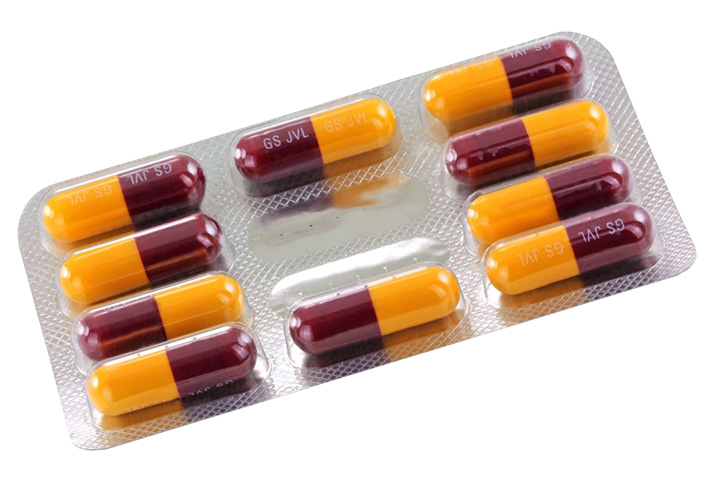Amoxil
Amoxil is a penicillin antibiotic. Its active ingredient, amoxicillin, destroys many bacteria that are responsible for frequent infections.
What Does Amoxil Contain?
Active ingredients
Amoxil 500:
- 1 Lactab contains: amoxicillin (as amoxicillin trihydrate) 500 mg.
Amoxil 750:
- 1 Lactab contains: amoxicillin (as amoxicillin trihydrate) 750 mg.
Amoxil 1000:
- 1 Lactab contains: amoxicillin (as amoxicillin trihydrate) 1000 mg.
Amoxil 200 mg / 4 ml, sugar-free, granulated for the preparation of a suspension.
4 ml of prepared suspension contains: amoxicillin 200 mg as amoxicillin trihydrate.
Excipients
Lactab: excipients.
Granules for the preparation of a suspension:
- aspartame, bergamot oil, vanillin and others, preservative: E 211 (sodium benzoate) as well as other excipients.
Forms and Strengths

Amoxil 500
- Packs of 20 (with groove).
Amoxil 750
- Packs of 20 (with groove).
Amoxil 1000
- Packs of 20 (with groove).
Amoxil 200 mg / 4 ml, sugar-free granules for the preparation of a suspension.
1 vial of granules for 100 ml of suspension (with 5 ml dosing pipette graduated to 0.5 ml).
Uses
Amoxil should only be used on medical prescription for the treatment of the following bacterial infections:
- infections of the nose, nasal/maxillary cavities, throat, tonsils and ear;
- infections of the respiratory tract (bronchi and lungs);
- kidney, bladder and urinary tract infections;
- gastric and intestinal infections, gastric or duodenal ulcers with proven Helicobacter pylori infection, in combination with a proton pump inhibitor and another antibiotic;
- genital tract infections (gonorrhoea, mucus secretion);
- gynaecological infections;
- skin and soft tissue infections (boils, abscesses, etc.);
- Lyme disease (redness caused by a tick bite, progressing centrifugally and accompanied by general organ problems such as headaches).
Amoxil is also indicated for the prevention of bacterial endocarditis during dental procedures (e.g. tooth extractions, scaling, fillings), endoscopies (exploration of the internal surfaces of hollow organs) and other procedures frequently associated with infectious risks.
A single dose of 3g of Amoxil is recommended:
- in the treatment of gonorrhoea and lower urinary tract infections (inflammation of the urethra or bladder);
- in the prevention of bacterial endocarditis during dental procedures or other procedures frequently associated with infectious risks.
How To Take
Taking Amoxil during or after meals does not alter its efficacy and even reduces the risk of side effects.
Lactab should be swallowed without chewing, if possible with a meal and plenty of liquid.
Dosage depends on the patient's age, body weight and renal function, as well as the severity of the infection and the sensitivity of the germ involved.
Unless otherwise prescribed by a doctor, the following dosage applies:
Adults and children over 40 kg
Mild to moderate infections: 375 to 750 mg of Amoxil 3 to 4 times a day.
Urinary tract infections: 4× 750 mg or 3x 1000 mg (3 g) in a single dose.
Lyme disease: In the case of a light-red circular patch, lighter on the inside than on the edge and progressing gradually (erythema migrans), 750 mg 3 to 4 times a day for 12 days.
Eradication of Helicobacter pylori:
- Adults: 2× 1 Lactab Amoxil 750 or 2× 1 Lactab Amoxil 1000 in combination with a proton pump inhibitor and another antibiotic for 10-14 days.
Children up to and including 40 kg
The appropriate dosage will be determined by the doctor according to your child's body weight and the severity of the infection.
For the treatment of infections in children, Amoxil suspension is recommended.
General recommendations
50 to 100 mg/kg body weight/day, divided into 3 or 4 doses, or:
3 × 200 mg
3 × 400 mg
Lyme disease
50 mg/kg body weight/24 hours in erythema migrans.
Prevention of endocarditis
Adults and children aged over 10: 3x1000 mg or 4× 750 mg (3 g) taken as a single dose approximately one hour before any procedure likely to result in bacterial infection.
Children up to 10 years: half the adult dose.
Special dosing instructions
Renal insufficiency (= poor kidney function).
You should inform your doctor if this is the case. He/she will then prescribe a dosage adapted to your own needs, which may differ from the above dosage schedule.
Once started, any course of antibiotics should be continued for the period prescribed by your doctor.
The symptoms of the disease often disappear before the infection is completely healed. If the treatment is applied for too short a time, or if it is stopped prematurely, there is a risk that the infection will flare up again.
Do not change the prescribed dosage or duration of treatment on your own initiative. Contact your doctor or pharmacist if you feel that the efficacy of the medicine is too low or too high.
Preparing the suspension
The suspension is normally prepared by the pharmacy. If this is not the case, add running water to the granules as follows:
- Amoxil Suspension 200 mg/4 ml, sugar-free, with dosing pipette
- Shake the bottle containing the granules. Carefully add tap water up to the mark on the bottle. Shake vigorously. Leave to stand for a moment. If necessary, add more water up to the mark on the bottle. This gives 100 ml of Amoxil 200 mg/4 ml suspension ready for use.
The suspension should be shaken before each use.
The medicine must not be used if, after opening the bottle, you notice the following:
- the membrane sealing the bottle opening is not intact
- there are lumps in the bottle
- the suspension is slightly coloured after preparation
Draw up the reconstituted suspension using the dosing pipette.
Shake the bottle before each use.
Insert the adapter supplied with the pack into the neck of the vial. The adapter connects the dosing pipette to the vial and must remain in the vial.
Push the dosing pipette firmly into the opening in the adapter. The plunger should be at the bottom of the pipette.
Carefully turn the bottle upside down with the dosing pipette. Slowly pull the plunger down to the mark corresponding to the prescribed dose in millilitres (ml). If any bubbles appear in the suspension, push the plunger back into the pipette and repeat the operation slowly.
Return the bottle to its normal position and remove the dosing pipette from the adapter.
Administering the reconstituted suspension using the dosing pipette.
The suspension can be swallowed directly from the dosing pipette or poured into a tablespoon or teaspoon. When administering directly into the mouth, the patient should sit upright.
Close the bottle tightly after use. After use, rinse the dosing pipette by filling and emptying it several times with clean water.
Side Effects
Taking Amoxil may cause the following side effects: digestive problems such as indigestion, nausea or diarrhoea. Reactions such as vomiting, the desire to vomit, stomach pains, loss of appetite, bloating and inflammation of the tongue or oral mucosa may also occur.
Gastrointestinal problems are less frequent if Amoxil is taken at the beginning of a meal.
Allergic reactions to Amoxil are common, as with all medicines in the penicillin group.
Skin rashes, redness, itching and urticaria may occur. Mycoses of the skin/mucous membranes have been observed very rarely.
Rarely, symptoms such as excitement, anxiety, insomnia, confusion, behavioural disorders, obnubilation and perceptual disturbances may occur.
Very rarely, sensations of dizziness, convulsions, hyperkinesia (excessive motor activity), changes in blood count, prolongation of bleeding time and prothrombin time, inflammation of the liver (hepatitis) or kidneys and disturbances in renal function have been observed.
After administration of the suspension, superficial changes in tooth colour have been described. These manifestations generally disappear with tooth brushing.
Very rarely, dark-coloured deposits on the tongue have been observed.
Enamel lesions (white stripes, discolouration) of the permanent incisors cannot be excluded in people who have received amoxicillin from 0 to 9 months of age.
In very rare cases, symptoms similar to the flu such as rash, fever, and swollen glands have been reported, accompanied by unusual blood test results. These results include increased white blood cells (eosinophilia) and elevated liver enzymes, a condition known as drug-induced hypersensitivity syndrome or DRESS syndrome.
Severe skin reactions have been reported.
Very rarely, chest pain has been observed. These may be signs of a potentially serious allergic reaction known as Kounis syndrome.
Jaundice has been reported rarely. Isolated cases of aseptic meningitis have been reported.
Consult your doctor immediately in the event of:
- urticaria, a large surface rash or redness of the skin;
- yellow discolouration of the skin or whites of the eyes;
- a sudden onset of stomach pains or vomiting;
- severe, bloody, or ongoing diarrhea;
- respiratory issues manifesting as asthma attacks or symptoms similar to hay fever.
If you notice any side effects not listed in this leaflet, please tell your doctor or pharmacist.
Precautions
This medicine may affect reactions, driving ability and the ability to use tools or machines.
Digestive disorders may occur when taking Amoxil. In the event of severe and persistent gastrointestinal symptoms such as vomiting or diarrhoea, you should stop taking Amoxil and inform your doctor immediately. The doctor or pharmacist should also be informed of any appearance of skin rash or itching.
In the event of diarrhoea, you should not take medicines that block intestinal movements (peristaltic movements).
If you suffer from allergies, asthma, hay fever or hives, you should take particular care when taking Amoxil because of possible hypersensitivity.
Cases of particularly serious, potentially fatal, skin reactions have been reported after taking Amoxil. The signs of such skin reactions are:
- flu-like symptoms and fever
- skin rash
- mucosal reactions (e.g. swelling of the lining of the mouth or throat, blistering, bleeding)
- swelling of the face or other parts of the body
- chest pain (Kounis syndrome).
If you notice any of these symptoms after taking Amoxil, you should stop taking it and consult your doctor immediately.
You should also tell your doctor if you have already experienced such symptoms (DRESS syndrome) in the past with other medicines, as amoxicillin may cause DRESS syndrome again.
Patients who must also take a medicine containing allopurinol (e.g. Zyloric) are more prone to skin rashes.
If you are taking a medicine containing digoxin, you should inform your doctor or pharmacist. The same applies if you are taking medicines that thin the blood (anticoagulants).
Penicillins may reduce the excretion of methotrexate (used to treat inflammatory joint disease, cancer and severe psoriasis), which may lead to an increase in unwanted effects.
Amoxil should be used with caution in patients with impaired renal or hepatic function.
If you are taking an oral contraceptive (the pill), please bear in mind that its effectiveness may be reduced during treatment with Amoxil. You should therefore take additional contraception during treatment with Amoxil.
Please inform your doctor or pharmacist if you:
- you are suffering from any other illness,
- you have allergies or
- you are already taking other medicines internally or externally (even if you are self-medicating!).
What else do you need to consider?
The antibiotic contained in Amoxil is not effective against all the micro-organisms that can cause infectious diseases. Using the wrong antibiotic, or the wrong dose, can lead to complications. So do not use it on your own initiative to treat other illnesses or other people. Nor should you use Amoxil for new infections without consulting your doctor again.
The symptoms of the disease often disappear before the infection is completely cured. So do not stop taking Amoxil prematurely, even if you feel better. This treatment can last up to two weeks, or even longer, depending on the circumstances and your doctor's prescription.
When should Amoxil not be used?
If you have had an allergic reaction to penicillins or cephalosporins in the past, you should not take Amoxil. An allergy, or hypersensitivity, is manifested in particular by symptoms such as red patches on the skin, fever or sore tongue.
Amoxil 200 mg/4 ml sugar-free suspension is sweetened with aspartame, which produces an amino acid (phenylalanine) during digestion. The suspension is not suitable if you have this rare hereditary disorder of the metabolism of this amino acid (a disorder called phenylketonuria).
Amoxil should not be used in the case of known or suspected hypersensitivity to any of its other components.
You should not take Amoxil if you have Pfeiffer's disease (infectious mononucleosis) or lymphatic leukaemia.
Pregnancy and Breastfeeding
During pregnancy, you should only take medicines of any kind with the utmost caution and after consulting your doctor or pharmacist.
Since Amoxil can pass into breast milk, sensitive infants may experience an allergic reaction (with symptoms such as skin rash and fever) or diarrhoea.
Amoxil should therefore not be taken during breast-feeding or breast-feeding should be stopped.
In any case, inform your doctor or pharmacist if you are pregnant, wish to become pregnant or wish to breast-feed. They are the only people who can decide whether you can take Amoxil during this period.
What is Gonorrhoea?
Gonorrhoea is a sexually transmitted infection that mainly affects men under the age of thirty. Gonorrhoea is the most common sexually transmitted infection after chlamydia. If left undiagnosed and untreated, this infection can lead to infertility.



